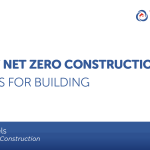The Green Revolution in Building: Net Zero Construction5 min read
Reading Time: 4 minutesMost of us are worried about the environment.
We recycle, buy more efficient cars and lightbulbs.
But how many of us boast a net-zero home energy usage?
Well, anyone who recently bought in a building built by Pat Daniels, Construction Manager at Urbandale Construction, can.
Pat is one of the pioneers of the Net Zero construction movement, which is radically transforming how the industry thinks about building.
He came on the show today to explain his energy-conscious building practices and offer some tips for anyone looking to dabble in green building.
- Why Net Zero construction is the future of the industry
- Why it’s not about the savings, it’s about the lifestyle
- The challenge of getting buy-in for green building
Green building is the future
If you haven’t watched the news, read a paper or spoken with any other humans at any point in the last 50 years, I’ve got some good news and bad news for you.
The good news is that your reading comprehension is fantastic for someone who just strolled out of a half-century sabbatical in a cave.
The bad news is humanity has done some major damage to the environment through our energy consumption.
But, more good news: People are starting to do something about it.
And when it comes to construction, green building and Net Zero construction is the path forward for a greener tomorrow.
Net Zero construction is a mode of building where the total amount of energy used by the infrastructure is roughly equal to the amount of renewal energy created on the site.
“Building houses that are green is very important. That’s the future for this industry.” — Pat Daniels
This is accomplished by using things like solar panels, better insulation and ensuring air leakage is very low in order to make a building as energy-efficient as possible. (One way Pat tests for this is filling a house with smoke and tracking down where it escapes).
There are obvious benefits to this when it comes to reducing waste and your carbon footprint.
And while the technique is currently being pioneered by a few trailblazers, Pat is confident it will become the industry standard.
In fact, Pat says that by 2030 the meticulous energy-efficiency Urbandale and others are pursuing right now may become fundamental elements of building codes across North America.
It’s about the lifestyle, not the savings
Now, while green building and Net Zero approaches do eventually amount to savings, this isn’t — and shouldn’t be — the primary motivation for building this way.
It’s actually all about the lifestyle.
“Being a green builder, you got to stay away from the cost-benefit conversation. It really is a lifestyle.” — Pat Daniels
Right now, shifting to a Net Zero footprint can be pretty costly in terms of up-front price.
And while the savings eventually catch up to the overhead, Pat says it would be a mistake to pitch people solely on cost.
Everyone knows the environment is a huge concern and there are plenty of people out there who want to do their part.
That’s how green builders should be approaching the topic — selling the lifestyle and ethical considerations of going green.
And as more people get on board with green building, the costs will inevitably be driven down, making a stronger case for those reluctant to make the switch for lifestyle.
Eventually, the savings will be too good to pass up.
The challenge of getting buy-in
Still, getting buy-in right now is challenging.
As much as people want to do their part for the environment, up-front costs might deter them.
But that’s only a small fraction of the problem.
The real issue is education.
“The biggest challenge with green housing is education and having people buy-in.” — Pat Daniels
As it stands right now, the concept of Net Zero construction, the technologies and technical expertise required are still unknown by many builders.
Luckily, pioneers like Pat aren’t just leading the charge in green building, they’re also getting the word out.
And part of that is helping curious construction organizations understand what goes into pulling off a truly efficient building.
Here are some of Pat’s top tips for anyone looking to dabble in Net Zero construction:
- Before you start any project, you need to make sure to really examine all of the links, attachments and weak points in the house.
- You need to make sure you understand what materials you are using (and how they fit in with existing systems).
- You need to really plan ahead of time. This isn’t something you do on a whim.
Making sure your building is properly sealed can be done through the smoke test we mentioned earlier. Any place where air can escape is a place where energy can escape.
This is also why materials matter. Often the weak points come from old and new materials not working well with each other.
When it comes to planning ahead, deciding things like which HVAC you will use before starting is crucial. Finding out you need to change these things halfway through a project can be costly — both financially and in terms of time.
Finally, while there is a ton of great new technology making green building possible, chasing that tech can get exhausting.
Really, you want to incorporate these new techniques with the tried-and-true staples of construction.
It’s not easy being green. But in the long run, it’s worth it.
The views, information, or opinions expressed during the podcast series are solely those of the individuals involved and do not necessarily represent those of Reliance Home Comfort™ and its team members.



